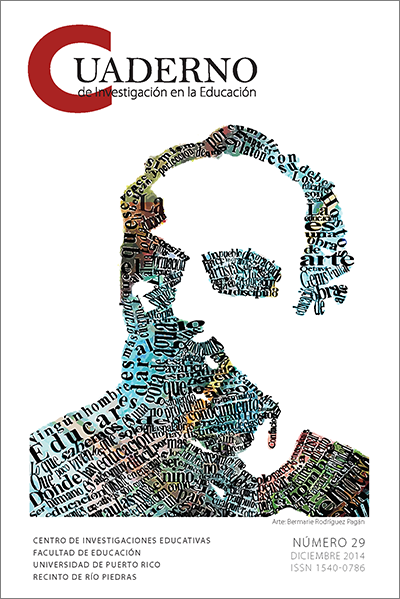Resumen
Las investigaciones sugieren que los maestros principiantes no están preparados, de manera efectiva, para usar la tecnología en el salón de clases. Mientras que muchos de los esfuerzos se han centrado en la preparación de los maestros en formación para integrar la tecnología a su práctica, pocos se han centrado en identificar los problemas internos que obstaculizan la capacidad de los docentes de las facultades de educación para integrar la tecnología en sus propios métodos de enseñanza. Por ello, el propósito de este estudio fue identificar dichos problemas internos. Al reconocer estos asuntos, surgieron discusiones que nos ayudaron a determinar estrategias que pueden apoyar, de forma sistemática, a los profesores al incluir la tecnología en sus clases. Se utilizó un cuestionario para recopilar los datos. Los resultados del estudio revelan que algunos profesores utilizaron la tecnología en sus clases de manera limitada a pesar de que deseaban hacerlo más consistentemente. Procesos internos, la necesidad de educación continua y la carencia de tiempo fueron algunas de las barreras que impidieron el proceso de integración de la tecnología en las clases.
How to cite:
Chung, M., Yeh, H.-T., Anderson, M., & Chavez, L. (2014). Identifying issues impeding teacher education faculty‘s ability to integrate technology in their teaching. Cuaderno de Investigación en la Educación, 29, 59-74. Retrieved from https://revistas.upr.edu/index.php/educacion/article/view/13254
Citas
Anderson, T., Varnhagen, S., & Campbell, K. (1998). Faculty adoption of teaching and learning technologies: Contrasting earlier adopter and mainstream faculty. The Canadian Journal of Higher Education, 28(2,3), 71-98.
Blackwood, N. A. (2001). A study of the relationship between characteristics of faculty members in West Virginia Colleges and their level of implementation of information technology. (Unpublished doctoral dissertation). West Virginia University, West Virginia.
Caffarella, R. S., & Zinn, L. F. (1999). Professional development for faculty: A conceptual framework of barriers and supports. Innovative Higher Education, 23(4), 241-254.
Casmar, S. P. (2001). The adoption of computer technology by faculty in a college of education: An analysis of administrative planning issues. (Doctoral dissertation). Available from ProQuest Dissertations and Theses database. (UMI No. 3025011).
Cornell, R. (1999). The onrush of technology and education: The professor‘s new dilemma. Educational Technology, 39(3), 60-64.
Davis, N. (1999). Why should IT in teacher education have a global dimension? In J. Price, J. Willis, D. A. Willis, M. Jost, S. Boger-Mehall (Eds.), Technology and teacher training annual – 1995 (pp. 795-800). Charlottesville, VA: Association for the Advancement of Computing in Education.
Dawson, V. (2008). Use of information communication technology by early career science teachers in Western Australia. International Journal of Science Education, 30(2), 203-219.
Georgina, A. D., & Olson, R. M. (2008). Integration of technology in higher education: A review of faculty self-perceptions. Internet and Higher Education, 11, 1-8.
Goktas, Y., Yildirim, S., & Yildirim, Z. (2009). Main barriers and possible enablers of ICTs integration into pre-service teacher education programs. Educational Technology & Society, 12(1), 193-204.
Hearne, J. L., Henkin, A. B., & Dee, J. R. (2011). Enabling initiative and enterprise: Faculty-led course redesign in a STEM discipline. Educational Research Quarterly, 35(1), 33-62.
Kirschner, P., & Selinger, M. (2003). The state of affairs of teacher education with respect to information and communications. Technology, Pedagogy and Education, 12(1), 5-17.
Koehler, M., & Mishra, P. (2009). What is technological pedagogical content knowledge (TPACK)? Contemporary Issues in Technology and Teacher Education, 9(1), 60-70.
Miller, M. T., Pope, M. L., & Steinmann, T. D. (2005). Dealing with the challenges and stressors faced by community college students: The old try. Community College Journal of Research and Practice, 29(1), 63-74.
Peluchette, J. V., & Rust, K. A. (2005). Technology use in the classroom: Preferences of Management faculty members. Journal of Education for Business, 80(4), 200-205.
Prenksy, M. (2001). Digital natives, digital immigrants. On the Horizon, 9(5), 1-6.
Sang, G., Valcke M., van Braak, J., Tondeur, J., & Zhu, C. (2010). Factors associated with the integration of ICT into Chinese primary school classrooms: An interplay of teacher-related variables. Journal of Computer Assisted Learning, 27(2), 160-172.
Semary, H. (2011). Barriers to the effective use of technology in education: Case study of UAE University. Asian Transaction on Science & Technology, 1(5), 22-32.
Tearle, P., & Golder, G. (2008). The use of ICT in the teaching and learning of Physical Education in compulsory education: How do we prepare the workforce of the future? European Journal of Teacher Education, 31(1), 55-72.

Esta obra está bajo una licencia internacional Creative Commons Atribución-NoComercial 4.0.
Derechos de autor 2014 Cuaderno de Investigación en la Educación

